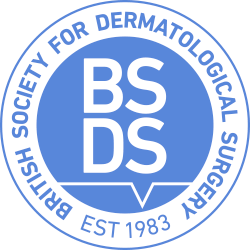Safe Practice Against Blood Borne Virus Infections
Safe Practice in High Risk Infection Patients
Prevention of and Protection Against Blood Borne Virus Infections (BBVI) in Dermatological Surgery
A doctor has a duty of care to all patients for whom he has responsibility irrespective of race, religion, age, sex, sexual or political orientation of disease state. However, patients also have a responsibility to disclose to medical attendants any disease they may have that may affect the health of the treating physician or surgeon.
The risk of contracting a blood borne virus infection varies with the individual virus. The risk of infection following needle stick injury with HIV infected blood is small and estimated at approximately 3 per 1000 injuries while the risk for infection from Hepatitis B is estimated at approximately 1 in 5 injuries.
Some needle stick injuries carry a higher risk than others, e.g. those resulting in deep injury, those caused by hollow bore needles, those where he source patient is terminally ill with HIV infection and those where needles are visibly blood stained or have been in an artery or vein. The risk of acquiring HIV through mucous membrane exposure is less than 1 in 1000. Many studies have revealed no evidence of risk where blood is in contact with intact skin.
Body fluids that may be responsible for BBVI are:
High Risk CSF, pleural, peritoneal, pericardial, amniotic and synovial fluids: breast milk, vaginal secretions, body tissue and semen
Low Risk urine, faeces, saliva, sputum, tears, sweat and vomit.
The blood borne viruses are:
HIV (AIDS) HBV (hepatitis) HCV (hepatitis) HDV (hepatitis) HTLVI (adult cell leukaemia)
Prevention
Some procedures carry a greater risk of exposure to blood and body products than others within the range of dermatological surgery. High risk involves those in which the potential for uncontrolled bleeding or spattering of blood is greater, e.g. open surgery. A lower risk would be associated with capillary oozing, e.g. shave biopsy, curettage and cautery, cold point cautery, de-roofing blisters, treating leg ulcers. Very low probability of personal contact during cryotherapy.
Specific protective measures required:
High Risk
- Gloves
- Water repellent gown
- Protective headwear
- Mask with visor
- Protective footwear
Low risk
- Gloves
- Protective eyewear
Very low risk
- Gloves to be available, e.g. for treating or dressing an ulcerated lesion
General preventative measures:
- Good basic hygiene with regular hand washing
- Cover any wound or skin lesion with waterproof dressing or wear gloves
- Protect mucous membranes of eyes, mouth, nose from blood splashes
- Transfer sharps by placing them on an instrument tray.
- Institute a safe procedure for handling and disposal of sharps, e.g. the operator should dispose of sharps and not leave a third person to tidy up
- Only resheath needles if resheathing apparatus is available
- Use appropriate instruments for putting on and taking off scalpel blades.
- Suturing needles should be stored in a safe place when not in use
- Potentially infected surfaces (e.g. a laboratory bench used for the preparation of micrographic specimens) and spillages of blood should be disinfected appropriately.
- Dispose of sharps in an appropriate puncture resistant container.
Note: Not all of the above preventative measures may be necessary all of the time. Departments should draw up there own code of practice for medical and nursing staff relevant to the tasks undertaken by that department in discussion with the Occupational Health Department and Microbiologists.
Immunisation
Effective immunisation is currently only available for HBV. All workers who regularly come into contact with blood or blood related products must be immunised against this virus.
Post Exposure Prophylaxis – Immediate Action
In the event of a sharps injury or other significant contamination, the following action should be taken without delay:
- Wash off splashes on skin with soap and running water
- Encourage bleeding if the skin has been broken
- Wash out splashes in the eye using solution from an eye wash bottle or alternatively tap water. Contamination of the nose or mouth should be washed with copious amounts of tap water
- Record source of injury, e.g. name, type of fluid, type of injury. Report incident to the expert medical adviser for risk assessment* and decisions about prophylaxis with anti viral drugs
- An accident report form should be completed
- Blood should be taken from the infection source and the injured party to establish the risk of infection (consent is required)
- Counselling may be needed for the injured party and infected source
*This individual may be in infection control, occupational health, public health, or the accident department.
In HIV infected persons the use of combinations of antiretroviral drugs suppresses viral replication. This has led to the introduction of prophylactic antiretroviral therapy following occupational exposure to HIV. Some of these drugs, especially the protease inhibitors carry significant and serious side effects.
References
- Guidance for Clinical Health Care Workers: Protection Against Infection with HIV and Hepatitis Viruses, January 1990 HMSO
- Protection Against Blood Borne Infections in the Workplace: HIV and Hepatitis Advisory Committee on Dangerous Pathogens HMSO 1995
- Guidelines on Post Exposures Prophylaxis for Health Care Workers Occupationally Exposed to HIV, UK Health Department June 1997
